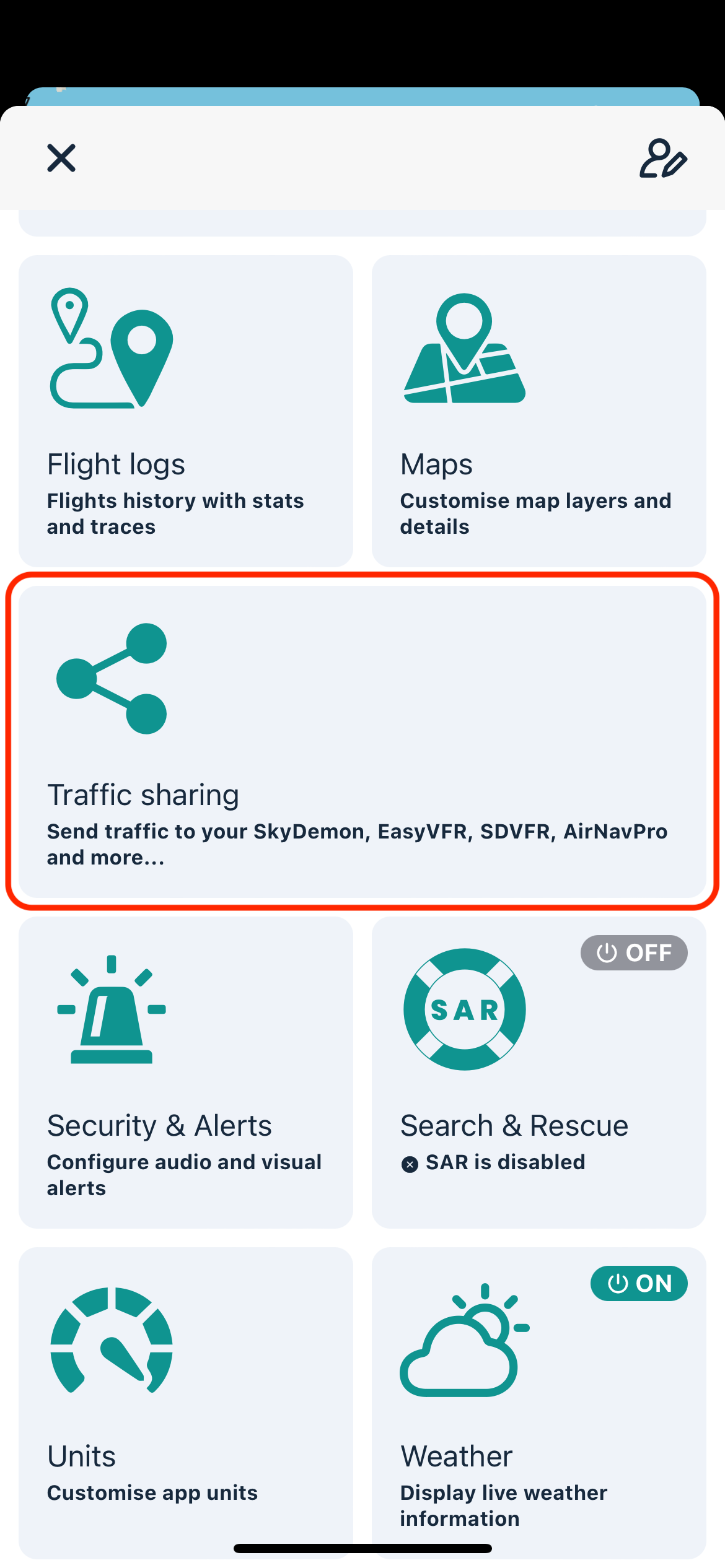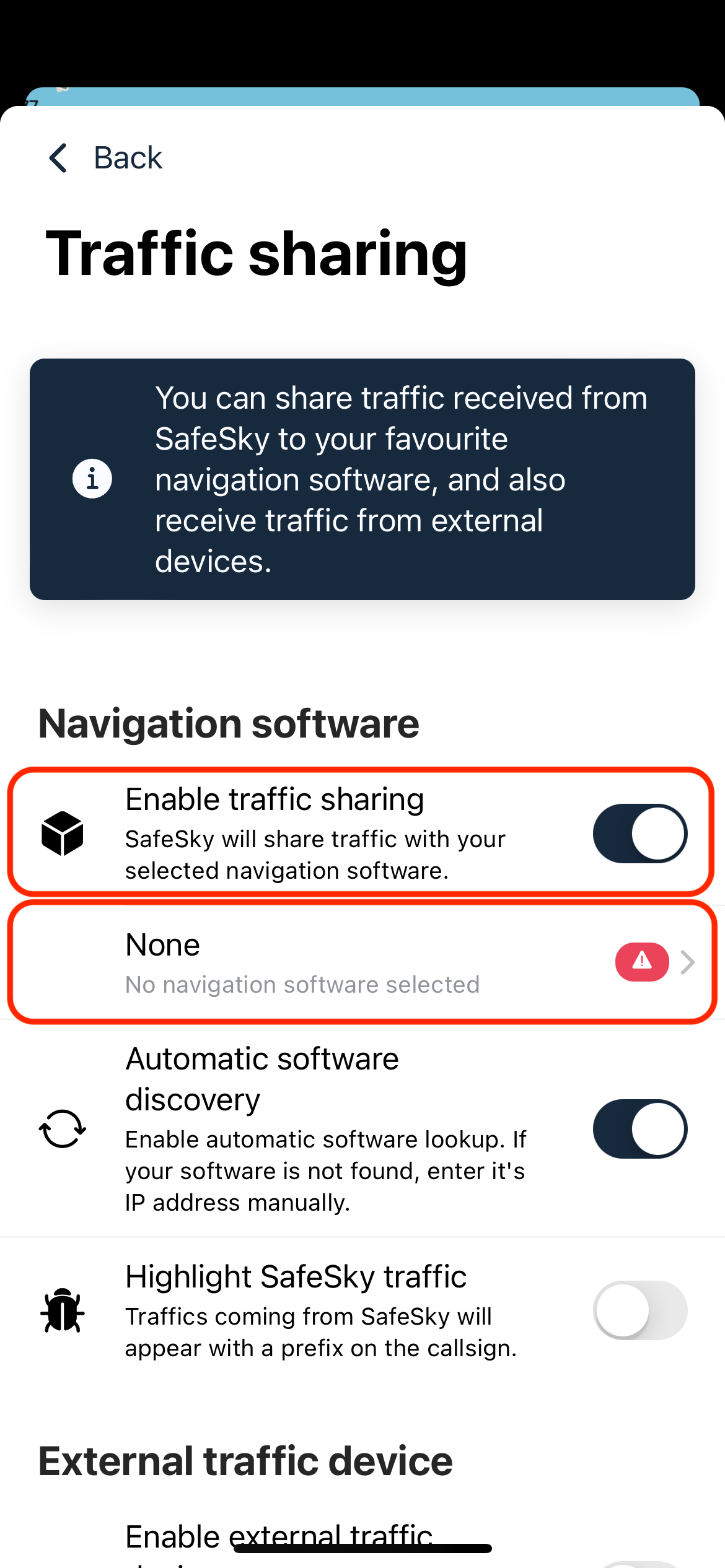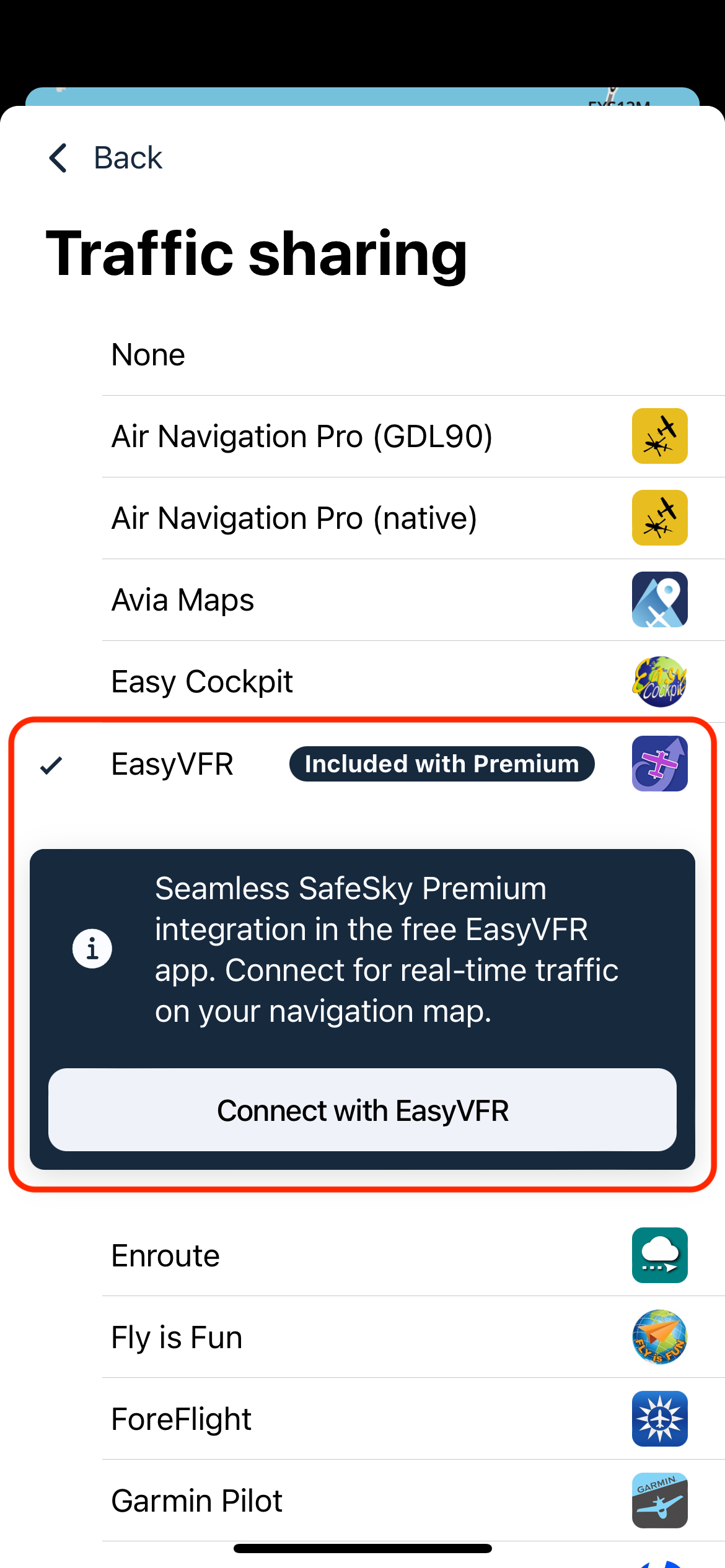Frequently Asked Questions
To address the most common questions and assist you in using SafeSky effectively, we have compiled a comprehensive list of Frequently Asked Questions (FAQ).
Configuration
Can I see SafeSky and my navigation app on one screen?
Absolutely!
You want to benefit from SafeSky's traffic but don't want a second screen. That's easy!
You have two options:
-
Run SafeSky on your phone or tablet and transfer the traffic to your EFB. This can be done on the same device.
-
Use the SplitView feature on iPad or Android to display SafeSky and your preferred navigation software on the same screen.
I have a FLARM and a mode-S or ADSB and/or a PilotAware: how can I configure SafeSky?
That's simple.
It's essential to have the same unique ICAO hexadecimal code on all your devices. To do so, simply enter it in SafeSky under "Settings > My aircraft > Callsign > Turn on the Transponder button", and the updated code will automatically appear.
It's important to configure all your external devices (such as FLARM, PilotAware, SkyEcho, Stratux, etc.) with the same hex code and address type set to "ICAO"
How can I see SafeSky traffic in my navigation app?
That's easy.
If you have SafeSky PREMIUM, you can view SafeSky traffic in the vast majority of the available navigation programs (full list here). This is a non-exhaustive list and there will be more to come. So, check it out regularly.
To set-up a split view, follow the simple steps as explained in Apple’s and Google’s tutorials on this topic.
I seem to see myself twice on SafeSky?
This is most likely to be a double echo, easy to solve.
If your aircraft is equipped with a radio transmitting device (such as an ADS-B out transponder, FLARM, SkyEcho) your signal is picked up by ground stations, shared with SafeSky servers, and retransmitted to you. SafeSky automatically detects this double echo in flight and asks you to confirm it's your aircraft. Otherwise, you can simply add your hexadecimal code in SafeSky. You can do this manually under "Settings > My Aircraft > Callsign > Turn on the Transponder button," and the hexadecimal code will be updated automatically. Note that all your external devices must be configured with the same hexadecimal code.
Using EasyVFR
If you're using EasyVFR, you probably forgot to add your callsign to EasyVFR configuration as described on this link.
When I use Android with SafeSky in the background, it seems to prevent SafeSky from working.
One setting in Android will do the trick.
Make sure that in the "Background Setting" section of your Android device, you have selected "No restrictions" for the SafeSky app, so it can operate continuously in the background. Also, ensure that no battery-saving settings are preventing SafeSky from running.
Functioning
Your application relies on the internet. Is there adequate internet coverage at high altitudes?
It's really good, check it out.
Some important things to know and consider:
-
SafeSky can still track your position even with a weak mobile internet connection as it uses a light protocol. A 2G (Edge) network is enough and the data sent is small, like fitting an hour's worth of flight data on a floppy disk.
-
In Europe, the internet coverage is generally good and SafeSky has a success rate of 86% for data transmission up to 5,000 feet. There may be spots with no coverage, but SafeSky will reconnect automatically once the connection is restored.
-
SafeSky's community is mostly pilots flying in E and G airspace classes up to 5,000 feet AGL. Above that, pilots usually fly in a different airspace.
-
For better internet coverage, make sure your mobile device is in a good position in the cockpit.
-
Check out our latest test case on how to improve mobile internet in flight.
Which traffic will I see when using SafeSky?
You will get the most complete traffic information service in-flight.
SafeSky collects and displays traffic data from almost 20 different protocols, including ADS-B, FLARM, OGN, and partially Mode S. While it may not show everything, it offers significantly more traffic information than a single system (even more than popular systems like Flightradar24) or no system at all, without any extra hardware or financial cost. Using SafeSky can give you at least "20 times more" traffic information, including exceptional traffic such as paramotor traffic. Of course, if other pilots aren’t using any detection device, SafeSky, like any other system, will not be able to see them. It’s like driving a car: if you do not turn on your headlights at night you cannot be seen … or too late.
P.S. It is important to acknowledge that SafeSky is not a radar, and therefore not intended to replace any existing e-conspicuity equipment, such as ADS-B in or FLARM receivers.
What is the added value of SafeSky when I am already using other devices (e.g. SkyEcho, Pilot Aware, Stratux, FLARM)?
Have a more complete and accurate picture of the traffic around you.
With most systems, you rely on a single source of traffic detection. SafeSky, on the other hand, combines almost 20 critical traffic detection sources such as ADS-B, FLARM, OGN and partially Mode S. By adding SafeSky to your existing solution, your knowledge of real traffic will increase exponentially.
In addition, it is compatible with your navigation software and integrates perfectly with existing devices.
In addition, by combining SafeSky with your existing device, you will allow the SafeSky community to benefit from the traffic picked up by your device (SkyEcho, Stratux, Pilot Aware, etc.).
Discover in video how SafeSky and Sky Echo can work together!
How do I get access to the weather reports?
At your disposal in the PREMIUM plan.
Weather reports (METAR) are accessible during your entire flight, indicating for each upcoming destination the weather you can expect.
Is there any benefit for me as paramotor/paragliding pilot to use SafeSky?
You would benefit from total harmony in the sky.
SafeSky is a tool designed to create harmony in the sky for all users, including paragliders who are the most vulnerable users due to the slow speed and closeness with fast aircraft like ULMs and GA planes. With SafeSky, tyou can improve safety simply by having your phone in your pocket. As a paramotor or paragliding pilot, you can receive alerts about surrounding fast aircraft. Additionally, SafeSky integrates traffic information from various sources, including dedicated apps like Gaggle, eVario, and XCTrack, as well as external devices such as SkyTraxx and Air3. By sharing in-flight positions through SafeSky's collaborative platform, paragliders, paramotor pilots and GA pilots can receive respective SafeSky traffic alerts.
Why should I use SafeSky when only few of my fellow pilots are using it?
SafeSky will provide you with traffic information even if your fellow pilots do not use SafeSky.
With over 50,000 pilot-users in our community, there is a good chance that your fellow pilots are using SafeSky. However, even if they would not be using it, there is definitely added-value for you. SafeSky collects traffic data from close to 20 other sources besides SafeSky, so we – and thus you as well when using SafeSky - can still see other aircraft even if they are not using SafeSky and alert them about potential traffic conflicts.
And … don’t hesitate to invite your fellow pilots to use SafeSky!
Does SafeSky aggregate Mode S?
Conversations are ongoing and constructive.
SafeSky is in close contact with the market’s major stakeholders in order to aggregate these data. In any case, as pilots, we would always recommend considering an ADSB-out solution as well, since today Mode S requires multilateration (more than 4 ground-based stations to be detected).
In which countries is SafeSky available?
SafeSky is today available in 40 European countries and in 8 languages, and growing.
Geographical expansion is constantly being investigated in line with legal and logistical obligations. Of course, if you have a European account today, this does not prevent you from using it outside of Europe if local legislation allows you to.
In addition, we regularly open up new markets outside Europe through our local partnerships (e.g. Turkey, South Africa, ...).
Can I use SafeSky while living outside of Europe?
That's possible.
If you downloaded the SafeSky application while being in Europe, you can use it anywhere outside Europe without any issues. Additionally, we frequently expand into new markets outside Europe by establishing local partnerships, like recently in Turkey and South Africa.
What is SafeSky's data consumption?
It is very low.
On average, traffic data consumption for one hour of flight is about 2 MB.
What is the battery consumption of my phone with SafeSky?
Thanks to the low data consumption, battery consumption with SafeSky is reasonable.
In comparisons, it’s using similar power as Waze or Coyote in your car.
Some helpful hints and techniques to maximise your battery life include:
- Use the SafeSky filters to only transmit the data you really need
- Plug in a charger
- Foresee an additional external mobile battery
How to unsubscribe?
We would be sorry to see you go.
Before you do so, we would love to understand why (please send us your feedback on info@safesky.app).
Still decided? This is what you should know and do:
Unsubscribing does not happen at SafeSky level but in your app store. Just follow their links:
How can I display SafeSky traffic at my airfield?
Setting up a display at your airfield to show all nearby air traffic is a straightforward process and can greatly enhance the experience for both pilots and visitors. By installing a computer or TV at your airfield, you can provide a real-time visualisation of the flight pattern, along with inbound and outbound traffic.
Why is this beneficial?
This setup not only improves situational awareness for pilots but also offers visitors an engaging way to understand the dynamics of air traffic, making their visit more informative and enjoyable.
How to set it up?
- Open the browser on your computer or SmartTV.
- Navigate to SafeSky Live Traffic. (https://live.safesky.app)
- Zoom into your airfield’s location. The system will remember this setting for future access.
- Customise your view by filtering for specific traffic altitudes, changing the map theme, and more.
No Aircraft appearing on the Map
Issue
If aircraft data is not displaying on the map, it could be due to an issue with your device's time settings.
Solution
To resolve this issue, follow these steps:
-
Check your device's time settings:
- On iOS, go to Settings > General > Date & Time.
- On Android, go to Settings > System > Date and time.
-
Enable automatic time setting:
- Ensure Set Automatically is turned on. If it is already on, toggle it off and then back on to resynchronize your device's time with the network.
-
Verify the accuracy of the time:
- Compare your device's time with other devices to ensure it is correct.
These adjustments should resolve the aircraft data display issue.
Compatibility
Is SafeSky compatible with SDVFR and SDVFR Next?
Yes.
SafeSky sends traffic via GDL 90 to SD VFR.
Is SafeSky compatible with Garmin, VFRnav, FlyWise, etc?
The decision is not solely ours to make.
Our desire is to be compatible with as many navigation software as possible and to be integrated into as many devices as possible. However, this decision is not only up to us. If you think SafeSky should be integrated with other applications or devices, do not hesitate to contact the relevant companies to let them know your need. We would love to explore new collaborative opportunities to improve pilot safety.
What devices and operating systems are required to make SafeSky work properly?
To run SafeSky, you need to have a phone or tablet with the following minimum configuration:
-
Android 6 + 2GB RAM minimum
-
Apple iOS 13 minimum
This is an Apple/Google Play decision.
If your device does not meet this minimum configuration, you will not be able to download the application from the various stores.



